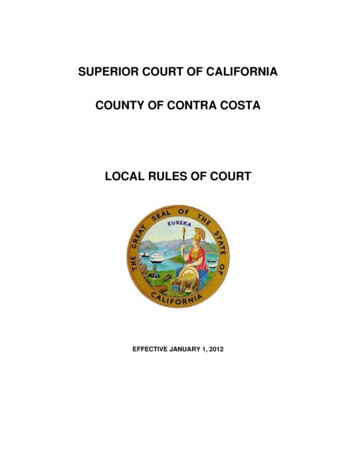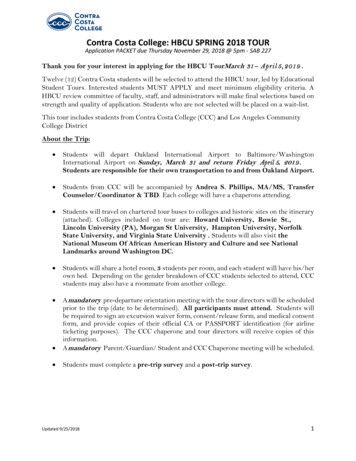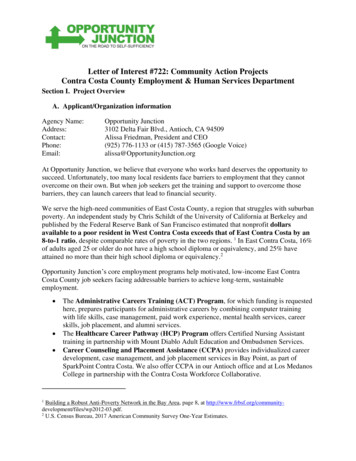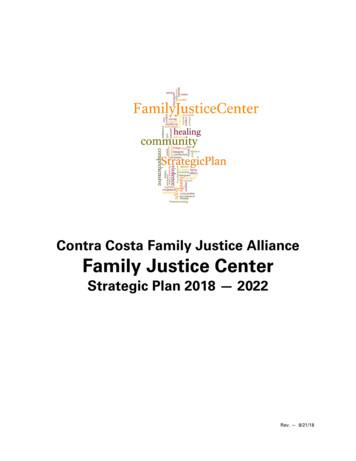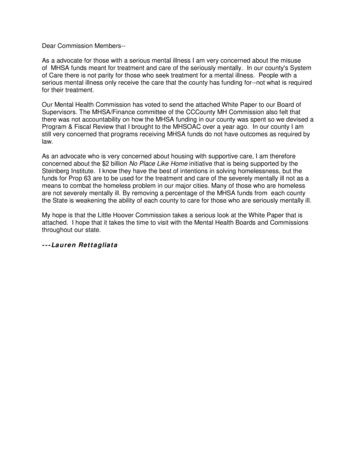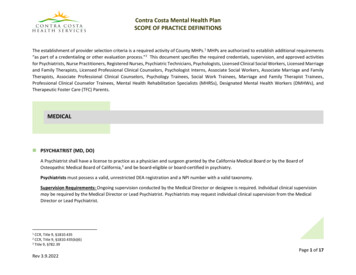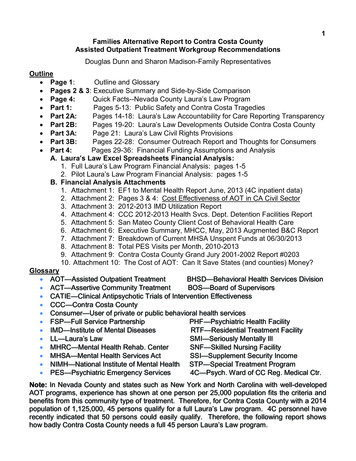
Transcription
Families Alternative Report to Contra Costa CountyAssisted Outpatient Treatment Workgroup Recommendations1Douglas Dunn and Sharon Madison-Family RepresentativesOutline Page 1:Outline and Glossary Pages 2 & 3: Executive Summary and Side-by-Side Comparison Page 4:Quick Facts--Nevada County Laura’s Law Program Part 1:Pages 5-13: Public Safety and Contra Costa Tragedies Part 2A:Pages 14-18: Laura’s Law Accountability for Care Reporting Transparency Part 2B:Pages 19-20: Laura’s Law Developments Outside Contra Costa County Part 3A:Page 21: Laura’s Law Civil Rights Provisions Part 3B:Pages 22-28: Consumer Outreach Report and Thoughts for Consumers Part 4:Pages 29-36: Financial Funding Assumptions and AnalysisA. Laura’s Law Excel Spreadsheets Financial Analysis:1. Full Laura’s Law Program Financial Analysis: pages 1-52. Pilot Laura’s Law Program Financial Analysis: pages 1-5B. Financial Analysis Attachments1. Attachment 1: EF1 to Mental Health Report June, 2013 (4C inpatient data)2. Attachment 2: Pages 3 & 4: Cost Effectiveness of AOT in CA Civil Sector3. Attachment 3: 2012-2013 IMD Utilization Report4. Attachment 4: CCC 2012-2013 Health Svcs. Dept. Detention Facilities Report5. Attachment 5: San Mateo County Client Cost of Behavioral Health Care6. Attachment 6: Executive Summary, MHCC, May, 2013 Augmented B&C Report7. Attachment 7: Breakdown of Current MHSA Unspent Funds at 06/30/20138. Attachment 8: Total PES Visits per Month, 2010-20139. Attachment 9: Contra Costa County Grand Jury 2001-2002 Report #020310. Attachment 10: The Cost of AOT: Can It Save States (and counties) Money?Glossary AOT—Assisted Outpatient TreatmentBHSD—Behavioral Health Services Division ACT—Assertive Community TreatmentBOS—Board of Supervisors CATIE—Clinical Antipsychotic Trials of Intervention Effectiveness CCC—Contra Costa County Consumer—User of private or public behavioral health services FSP—Full Service PartnershipPHF—Psychiatric Health Facility IMD—Institute of Mental DiseasesRTF—Residential Treatment Facility LL—Laura’s LawSMI—Seriously Mentally Ill MHRC—Mental Health Rehab. CenterSNF—Skilled Nursing Facility MHSA—Mental Health Services ActSSI—Supplement Security Income NIMH—National Institute of Mental Health STP—Special Treatment Program PES—Psychiatric Emergency Services4C—Psych. Ward of CC Reg. Medical Ctr.Note: In Nevada County and states such as New York and North Carolina with well-developedAOT programs, experience has shown at one person per 25,000 population fits the criteria andbenefits from this community type of treatment. Therefore, for Contra Costa County with a 2014population of 1,125,000, 45 persons qualify for a full Laura’s Law program. 4C personnel haverecently indicated that 50 persons could easily qualify. Therefore, the following report showshow badly Contra Costa County needs a full 45 person Laura’s Law program.
Families Alternative Report to Contra Costa CountyAssisted Outpatient Treatment Workgroup Recommendations2Executive SummaryDouglas Dunn and Sharon Madison-Family RepresentativesWe are most thankful that, after 8 months of work, the workgroup has recommended badlyneeded county Behavioral Health system improvements.In particular, we appreciate andstrongly support the establishment and robust MHSA / county BHSD funding of:1. County In-Home Outreach Team and treatment engagement phone line. This “plugs” amajor gap in family and consumer behavioral health services identified by the workgroup.2. Educating and Coordinating with the Consumer’s Support network. In particular, hiring aBehavioral Health Navigator at each adult clinic would greatly help care givers and/orfamily members better “navigate” the county system to help consumer loved ones receivebetter care.However, we disagree with the 3rd recommendation for a small 10 person Laura’s Law “pilotprogram” and an intimated 6-9 month implementation timeline. Unlike a tenuous “pilot,” a full45 person county Laura’s Law program implemented July 1, 2014 would immediately: Greatly reduce threat of violence to the public by completely psychotic seriously mentally ill(SMI) persons.Could be funded by a combination of MHSA and BHSD budget dollars. There is nearly 55 million unspent available dollars as of June 30, 2013, which exceeds the cumulativerecommended Prudent Reserve amounts by over 8 million for the 5 MHSA programs.Reduce associated hospitalization, out-of-county conservatorship placement, and jaildetention costs by nearly 5 million annually, and ongoing state hospital costs by over 5.7 million annually; thus actively encouraging ongoing voluntary service programsexpansion of nearly 10.7 million annually.Require FSP multi-discipline “accountability of care” reporting transparency that wouldquickly correct the inadequate county oversight of mental health service delivery, spending,and MHSA programs.Provide a kind, helpful civil rights “guiding hand” to help SMI persons who do not know theyare ill to receive sustained, badly needed “community recovery” treatment.By contrast, a 10 person pilot program (see attached Pilot program spreadsheets, pp. 1-3): Would only “touch the surface“ violence threat to the public by completely psychotic SMIpersons. Reduce hospitalization, out-of-county conservatorship placement, and jail costs from a rangeof 1,008,683 to 1,154,034 while likely incurring costs of approx. 568,500- 650,000 for aprogram savings of only 364,000- 485,000. Increase variable per client cost of care services from a range of 25,000- 48,000 up to 65,000 because of a much smaller number of persons served. Only slowly correct the inadequate “responsiveness of care” and records reporting andoversight problems that currently plague county mental health services delivery, spending,and MHSA programs. Would not produce enough data to show the effectiveness of treatment outcomes. Theresults for the 10 people selected, whether positive or negative, may not be representative ofthe population Laura’s Law is intended to serve. Therefore, it would not inform the issue ofwhether to enlarge the program.
Side by Side Laura’s Law Programs Comparison Full Laura’s Law ProgramMaximum Number of Clients: 45Greatly reduces public safety threat posedby some completely psychotic SMIpersons.Quickly corrects inadequate Quality ofCare, data reporting and many oversightissues.Provides numerous Civil Rights protections Annual Hospital Savings: 2,329,763Annual Out-of County ConservatorshipSavings: 2,362,068 Annual Jail Detention Cost Savings: 231,045Annual Out-of-County State Hospital CostSavings: 5,770,823Maximum Annual “Cost Avoidance:Savings: 10,693,698 Annual FSP-AOT per Client Costs: 25,000Maximum Annual per Client AdditionalServices and Housing Costs, if needed: 13,442Maximum Annual per Client Court Costs, ifneeded: 9,915 “Cost Avoidance” Success Rate: 75% Per client level of costs do not varybecause of proved service effectivenessand efficiency Full programs proven to work in NevadaCounty, State of New York, and NorthCarolina 3Pilot Laura’s Law ProgramMaximum Number of Clients: 10Barely “grazes” the public safety threatposed by some completely psychotic SMIpersons.Only gradually corrects inadequate Qualityof Care, data reporting, and manyoversight issues.Provides numerous Civil RightsprotectionsAnnual Hospital Savings: 514,243 - 511,114Annual Out-of County ConservatorshipSavings: 464,443 - 448,293Annual Jail Detention Cost Savings: 74,348 – 71,951Annual Out-of-County State Hospital CostSavings:NONEMaximum Annual “Cost Avoidance:Savings: 1,054,034 - 1,031,359Annual FSP-AOT per Client Costs: 25,000Maximum Annual per Client AdditionalServices and Housing Costs, if needed: 18,330 - 20,000Maximum Annual per Client Court Costs, ifneeded: 13,520 16,750”Cost Avoidance” Success Rate:UnknownCost Savings and Per client level of costsvary because service effectiveness andefficiency are Unknown due to reportingissues.Does not effectively inform whether toenlarge the program because of currentreporting issues.
Quick Facts—Current Full Laura’s Law programsNevada County: 2009-2011: 31 months12 mos. Pre-treatment vs. Post-treatment involving 43 unduplicated persons # of Psychiatric Hospital Days:212 days vs. 76 days 64.2% decrease # of Incarceration Days:156 days vs. 123 days 21.2% decrease # of Homeless Days:1,114 days vs. 72 days 93.5% decrease # of Emergency (5150) Interventions: 93 contacts vs. 12 contacts 87.1% decrease4Key Indicators: Pre-AOT Post-AOT SavingsHospitalization—Pre AOT: 346,950 Without AOT: Projected Hospital & Jail Costs:Hospitalization—Post AOT:- 133,650 1,122,264Laura’s Law Savings: 213,300AOT program cost: 483,433Incarceration—Pre AOT: 78,150Hospital and Jail Costs: 136,200Incarceration—Post AOT:- 2,550Total AOT (Laura’s Law) Costs: 618,653Laura’s Law Savings: 75,600AOT program savings (in dollars): 503,651AOT program savings, percent:45% AOT dollars savings: 1.81 for every 1 previously spent on “revolving door” care. From Michael Heggarty, NV County Behavioral Health Director—November 15, 2011Nevada County Court cost savings: Could not be precisely quantified. However, theHonorable Thomas Anderson, Judge of the Nevada County Superior Court and AOT Courtspoke at the December 19, 2013 NAMI-Contra Costa general meeting on Laura’s Law. Fromhis 6 years of AOT judicial experience, Laura’s Law court costs and time, on average, take s¼ ofthe time and cost involved in LPS Conservatorship hearings. This has been true, even with thesmall annual number (5) of contested Laura’s Law hearings per year. As a result, the expectedbudgeted increased court costs have NOT materialized. This is because Laura’s Law is a greatLPS Conservatorship “diversion” tool, with far less legal costs and time involved.This has tremendous implications for Contra Costa County (CCC). Unlike rural NevadaCounty, CCC has a large Out-of-County LPS Conservatorship population, averaging 95-130 foreach of the past 14 years. In addition, the Out-of-County Conservatorship costs have more thandoubled, from 5,324,218 in fiscal year 2000-2001 to a likely 11,666,667 in fiscal 2012-2013.A full 45 person CCC Laura’s Law program would: Reduce 4C hospitalization costs by at least: 2,329,763 / year Reduce Out-of County LPS Conservatorship costs by at least: 2,362,038 / year Reduce Out-of-County State Hospital costs, in time, by at least: 5,770,823 / year Reduce Martinez Detention Facility costs by at least 231,045 / year For likely “avoided cost” savings of at least: 10,693,098 / yearMaximum annual cost: Total FSP-AOT Cost: 1,125,000Max. BHSD Staff, Svc., and Housing Costs: 604,890Max. MHSA funded Laura's Law costs: 1,729,890Maximum Public Defender Costs: 223,080Maximum County Counsel Costs: 223,080Max. CCC BHSD Laura's Law Costs: 446,160Maximum Laura's Law Costs: 2,176,050Now, let us turn our attention to the issue of public safety and tragedies involving our SMI lovedones. They powerfully illustrate the desperate need for a full Laura’s Law program.
Part 1: Public Safety51. “Individuals with schizophrenia and related psychotic disorders are no more violent thangeneral population when they are in treatment and symptoms are well controlled.”2. However, per the NIMH-CATIE study of persons with schizophrenia, symptoms of losingtouch with reality (delusions and hallucinations) increase odds of violence nearly 3 timesthe normal rate.3. Breaking the cycle of treatment non-compliance caused by severe anosognosia is thekey to preventing possible violence.thCited in I AM Not Sick, I Don’t Need Help, 10 Anniversary Edition (2012), pp. 216-218, XavierAmador, Ph.D.What is anosognosia (pronouncedreality) affect the brain? ano-sog-no-sea) and how does psychosis (break withThis big word means that, when a person becomes mentally ill, their brain wiring oftenbecomes impaired, “twisted,” or, in severe cases, “broken.” As a result, up to 50% ofmentally persons, to a varying degree, cannot recognize their brain is seriously mentally ill(SMI). The result is often deficits in the SMI person’s frontal lobe and in their brain’sexecutive (processing information and rational reasoning) functioning . This is a scientificfact validated by over 30 major clinical trials over the past 20 years.In addition, each psychotic break tends to further damage cognitive brain functions. This isvalidated by 10 brain imaging and 5 large clinical observation studies over the past 15 years.These 2 facts corroborate what families of SMI loved ones in this county and around the worldhave known and experienced for many years. Namely, there is a clear link between lack ofinsight (impaired capacity for objective self-reflection) and treatment nonadherence, resulting in: Far greater illness relapse, and, Poorer response to treatment, and, “Revolving door” hospitalizations, which often lead to: Incarceration, or Victimization, or ViolenceSource: Assisted Outpatient Treatment: Preventative, Recovery-Based Care for the MostSeriously Mentally Ill, p. 16, The Resident’s Journal, a Publication of the American PsychiatricAssociation, Volume 7, Issue 6, June, 2012, Gary Tsai, M.D.Dr. Fred Frese, Ph.D., Associate Professor of Psychiatry at Northeast Ohio Medical University,is a consumer who has lived with schizophrenia since 1966. He strongly supports AOT lawsbecause they are far preferable to 5150 hospitalizations, incarceration, or hostile street life.The following pages (3-10) vividly portray the profound public safety risk, extremely high cost ofcare, as well preventable tragedies resulting from treatment non-compliance by our county SMIconsumer loved ones. A full 45 person Laura’s Law program beginning July 1 would be avaluable additional “continuum of care” tool to “slow down” and prevent such situations. OurSMI consumer loved ones have been the ultimate victims of a dysfunctional, broken countysystem of behavioral health care. They, and us, their families, do not prefer a small, tenuous 10person 1 year pilot program that could take 6-9 months to implement with insufficient fundingand reporting requirements. As the financial section of this report will make clear (Part 4),there is absolutely no reason, whatsoever, not to implement a full 45 person Laura’s Lawprogram right away. The time for “baby steps” is past. Now is the time for county leadershipto demonstrate cost-effective, humane help and care for our SMI loved ones!
Threat of violence and costs of Crisis Stabilization: Contra Costa Examples6West County Consumer Has had numerous hospitalizations, 16 consecutive 1 year LPS conservatorships and is atNapa State Hospital (NSH) with 2 arrests, costing CCC at least 848K in the past 4 years, 185K and counting, in the past year alone.Central County Consumer Over a period of 7 years (84 months) - a total of 25 months (a third of his time) spent in longterm facilities costing the county 400K, 295K in the past year alone. This consumer wasreleased from a state hospital at the end of last year and would have “dropped through thesystem hole” had family not been there to actively support him.East County Consumer Person requested right to a firearm after his 1st county hospitalization in July, 2007 and had 5hospitalizations from April, 2012-February, 2013, costing CCC approx. 160K. In July, 2010, in a psychotic rage, this consumer shattered the door frame of his parents’home, threatening them with incalculable physical harm. On July, 20, 2012, his father warned the consumer’s county Case Manger that this consumerwas capable of an “Aurora, CO style” massacre. 34 days later, on August 24, this consumer:1. Showed up on parents’ doorstep complete psychotic. Father drove this consumer topsych. emergency in Martinez because the local police dept. was too undermanned torespond.2. When this consumer fled the car, two CIT trained sheriff’s officers had to taser him to gethim into treatment.3. Per Case Manager, client’s lack of insight into illness is “severe.” From the following documents and pictures, his August, 2012 psychotic break was aprofound “public safety” and “quality of life” threat to Contra Costa County.July 20, 2012 e-mail to consumer county Case ManagerHi again (Case Manager):In light of the Colorado movie massacre, we trust that, due to diagnosis,cannot purchase a gun or similar weapons. Because of the anger due to"broken/stuck" mind, we fear could cause great bodily harm to us and to others ifever "got hands" on such weaponry.Thought you should know.Sincerely,
July, 2007 Right to Bear Arms Request7
8Public Safety Threat of August, 2012 self-imposed Homeless EncampmentSelf-imposed homeless encampment discovered August 25, 2012 within 215 feet of nearbyelementary school. This consumer had completely “lost touch” with reality. School was alreadyin session when this homeless encampment was discovered.Elementary school and playground just over 200 feet from self-imposed homeless encampment.School was in session in August, 2012 when this consumer set up his homeless encampment.
9Public Safety Threat: August, 2012 self-imposed Homeless Encampment (cont’d)400 member church within 250 feet of self-imposed homeless encampment, August, 2012.8-plex apartment complex occupied 24/7 w/in 350 feet of homeless encampment, August, 2012.
10Public Safety Threat: August, 2012 self-imposed Homeless Encampment (cont’d)A public theatre complex w/in 700 feet of homeless encampment, August, 2012.A public high school w/in 1000 feet of homeless encampment, August, 2012.
Seriously Mentally Ill (SMI) Contra Costa County Tragedies11Date: 9/2012Location: Walnut Creek, CASummary: On September 4, 2012, 36-year-old Christopher Boone Lacy, diagnosed with bipolardisorder, shot a California Highway Patrol officer, 37-year-old Kenyon Youngstrom. Youngstromdied the next day. Youngstrom had stopped Lacy for an obscured license plate. Lacy was fatallyshot by a fellow officer after Youngstrom was shot.Source of Information: Contra Costa Times, 9/6/12; Monterey County Herald, 9/6/12; CBSLocal, 3/21/13Record ID: 2518Date: 8/2011Location: Discovery Bay, CASummary: On August 27, 2011, Brian Dawson was arrested by police after they were called tohis house for reports of yelling and fighting. Dawson's wife was injured but not taken to ahospital. Dawson said he was Bipolar and had been off medication for more than three monthsbecause he lost his medical insurance and could not afford to pay 2,400 for the medication.Prosecutors charged Dawson with misdemeanor spousal battery and child endangerment.Source of Information: Contra Costa Times, 9/22/11Date: 1/2010Location: Bethel Island, CASummary: On January 28, 2010, Ronald Joseph Reid, an armed and suicidal man, was shotafter holding authorities at bay. Reid, 48, had stopped taking medication for an undisclosedmental illness and had at least one prior run-in with police involving a threat to kill himself, theContra Costa County Sheriff's Office said.Source of Information: Contra Costa Times, 1/29/10Record ID: 6191Date: 8/2009Location: Antioch, CASummary: In August 2009, authorities accused Phillip Garrido, a paroled sex offender, withkidnapping, raping and imprisoning Jaycee Dugard for 18 years in a lot behind his house.Garrido had long been known as an odd and sometimes frightening character to neighbors,business associates and even the few people who called him a friend but recently Garridoseemed to have been even more unhinged, apparently posting mad ramblings online that hintedat deepening delusions. Many of these were dotted with references to governmental mindcontrol and something he called “cultural trance,” whereby “large bodies of people haveaccepted something as truth.” “The Creator has given me the ability to speak in the tongues ofangels,” read a posting from August 14, under the name TheManWhoSpokeWithHisMind. “Source of Information: New York Times, 8/30/09; Sacramento Bee, 2/25/10 Record ID: 5743Date: 10/2007Location: Oakley, CASummary: On October 28, 2007, 49-year-old James Brennan was fatally shot in the heady byOfficer Ian Jones. Brennan had stopped taking his medication for bipolar disorder and wasconsuming alcohol and marijuana leading up to the night of his death. That night, Brennandisrupted a sports banquet in Antioch and got into a fight with patrons of an Oakley bar beforehe drove to his son's house asking for a gun.Source of Information: Mercury News, 12/4/08; Antioch Press, 12/11/08 Record ID: 1615
Seriously Mentally Ill (SMI) Contra Costa County Tragedies (cont’d)12Date: 2/2007Location: Richmond, CASummary: On February 20, 2007, a mentally unstable man allegedly killed his father in thefamily home. Angelito Ares, 20, called 911 at 6:21 p.m. from his home in the suburban MayValley neighborhood of Richmond to report a violent altercation with his father in the house theyshared. Police arrived with lights and sirens, stopping the son as he was leaving the house."There was some evidence of a struggle. He had blood on him," said Richmond police DetectiveDan Sanchez. Officers found 59-year-old Rolando Ares dead of knife wounds in the living room.Angelito Ares, who has a history of mental illness, made statements implicating himself, policesaid. He was arrested on suspicion of murder and booked into County Jail in Martinez. "Itappears the suspect had a long history of mental disorder. The father had been attempting tohelp him with those issues, and had actually taken him in the past two years," Sanchez said.Source of Information: Contra Costa Times, 2/22/07Record ID: 4387Date: 2/2007Location:Richmond,CASummary: On February 15, 2007, police arrested 19-year-old Lymus Howard in the death of his59-year-old mother, Katy Lee, inside her home in the Pullman apartment complex in Richmond.Police say Howard pummeled Lee with his fists, then walked to Nevin Park and told severalpeople, "I just killed someone." A local pastor said Howard had suffered emotional problemssince age 6 when he saw his father shot dead. Friends said his mother battled with Howard toget him to take his medication.Source of Information: Contra Costa Times, 2/22/07Record ID: 2306Date: 11/2006Location: Danville, Contra Costa, CASummary: On November 6, 2006, 16-year-old Andrew Mantas bludgeoned his mother to deathin her home. Shortly after police found the body of 43-year-old Dimitra Mantas, they arrestedAndrew in Blackhawk, where he was spotted driving a stolen golf cart. Andrew had a history ofbehavioral and psychological problems, including documented substance abuse, expulsionsfrom two schools in two years and several run-ins with police. Mantas had been actingerratically for a year and a half before the incident. His parents sought help from doctors. Twodays before her death, Dimitra took Andrew to the family's church, where he told the pastor hewas hearing voices and believed he was possessed by demons. Mantas was found not guilty byreason of insanity and faced spending the rest of his life in a state mental hospital. Mantas,diagnosed with Schizophrenia, was charged as an adult with murder and an enhancementaccusing him of using a deadly and dangerous weapon to kill his mother.Source of Information: Contra Costa Times, 11/22/06, 6/14/11; KYVU.com, 1/30/07; SanFrancisco Chronicle, 5/31/08, 9/14/11Record ID: 4385Date: 7/2005Location: Walnut Creek, CASummary: In July 2005, Robert Clouthier, 29, was arrested after arguing with his father,destroying a china cabinet and jumping through a plate glass window at his parents' WalnutCreek home. Clouthier was bipolar and was living on the street in Walnut Creek at the time ofhis arrest. Clouthier was booked on suspicion of battery and vandalism and told a jail healthworker he was suicidal. The worker learned that Clouthier had repeatedly tried to kill himself,most recently two months earlier. When the worker's shift ended, she gave her notes to NancyBlush, a mental health specialist, and told her that Clouthier was still suicidal. He hangedhimself from a knotted bed sheet that night.
Seriously Mentally Ill (SMI) Contra Costa County Tragedies (cont’d)Source of Information: San Francisco Chronicle, 1/15/1013Record ID: 5290Date: 6/2005Location: Pleasant Hill. CASummary: A 43-year-old Pleasant Hill, CA man with a history of mental illness is suspected ofusing a hammer and a frying pan to fatally bludgeon his 84-year-old mother on June 6, 2005 inthe apartment they shared. Police arrested Luis Hector Morilla after he called 911 that eveningto report that his mother, Virginia Morilla, was injured inside the apartment. Morillo's brother,Julio Lopez, told police that his brother was a promising engineer until he had his first psychoticepisode at age 21, and never worked again. He was later diagnosed with bipolar disorder.Morilla told a Martinez police officer that he struck his mother because he thought she was thedevil and needed to kill her.Source of Information: San Francisco Chronicle, June 7, 2005Record ID: 4315Date: 3/2004Location: San Ramon, CASummary: A woman with bipolar disorder apparently committed suicide by overdosing on hermedication in a hotel room in San Ramon, CA on or about March 12, 2004. Patricia Noel, 58,checked into the Sierra Suites Hotel on Friday, March 12. Her body was found by hotelemployees on Sunday, Investigators were able to contact Noel's psychiatrist, who confirmedshe was being treated for depression and a bipolar disorder.Record ID: 4932Date: 1/2004Location: Antioch, CASummary: Authorities believe that Gary Armstrong, 48, shot and killed his wife, his son andhimself in their Antioch, CA home on January 22, 2004. Detective Will Dee said investigatorshave not determined a motive for the murder-suicide, but they are looking into reports thatArmstrong, 48, suffered from a bipolar disorder and was taking prescription medication for it.Source of Information: Contra-Costa Times, January 25, 2004Record ID: 5169Date: 3/2002Location: Danville, CASummary: Jeanne O’Brien acknowledged in Contra Costa County court that she murdered hermother, Claire O’Brien, on March 27, 2002, at their home in Danville, a suburb east of SanFrancisco. Prosecutors agree that she was legally insane at the time. O'Brien, who has beendiagnosed as suffering from schizophrenia will be committed to a state mental hospital for aslong as 26 years to life.Source of Information: The Associated Press, May 17, 2003Record ID: 3648
Part 2A: Laura’s Law “Transparency” Reporting Requirements14NOTEIn our initial 10/23/2013 financial data request, we specifically asked how the county determinesif a MHSA recipients have properly spend contract funds (pages 15 & 16). The county FinanceDept. answer was: “By approving payments.” This shows a lack of financial oversight on thepart of both the county Finance Dept. and Behavioral Health Services Division (BHSD).On 11/26/2013, we submitted a second financial data request asking for more specific“traceable” data (pages 17 & 18). At the 12/04/2013 workgroup meeting, we were told therequested information does not exist. However, we were told that improved data and recordkeeping, for which we had given a “road map,” would be implemented in the future. To us, thisfurther shows a basic lack of patient/client treatment tracking processes which only the explicitreporting requirements of a complete 45 person Laura’s Law program listed below wouldconclusively rectify.Laura’s Law Reporting RequirementsAgreed upon settlement or judicially ordered treatment service plan for a:Maximum 180 days, renewable for a maximum of another 180 daysService plan shall include:Assertive Community Treatment team of highly trained mental health professionals at amaximum 10:1 client/staff ratio.Report showing the number of persons to be served and the services and programs provided tomeet their needs.Report showing: How support for families of the served persons is provided in the treatment plan How services for the physically disabled persons are provided How services for the older adult persons are provided How psychiatric and intensive client-directed and psychosocial rehabilitation andrecovery principles based counseling services are provided for the served persons How immediate, transitional, or permanent housing is provided for the served personsReport showing the dollar amount and types of funds annually expended for AOT servedpersons as well as the benchmark success or failure rate of each person.Consumers’ friends and families greatly appreciate the family “friendliness” reportingimprovements of the workgroup’s first two recommendations. However, we are a bit “jaded” bypast as well as current lack of “accountability of care” and records keeping performance. We’refrom Missouri and “show us.” A full Laura’s Law program will “show us” that the countybehavioral health system is serious about “Performance Improvement Project” improvedpatient/client care, record keeping, and financial reporting.
Financial Data Request Attachment15Pilot AOT work group family members CCC Mental Health Budget Information RequestOctober 23, 2013We request the following budget and financial information in a very timely manner (within 3weeks or the 11/20/2013 meeting at the very latest):The detailed and summarized Behavioral Health Budget for the current fiscal year (2012 -2013)and all years since MHSA implementation, including: Out-patient Psychiatry costs (including Medi-Cal and/or Medi-Care costs)80 page Psychiatric outpatient centers document—NOT attached. Mammoth Electronic FilePsychiatric Emergency Services.EF1 ID to Mental Health June, 2013 Report—Attachment 1In Hospital (4C) 5150, 5250, T-Con, and “administrative days” county as well as Medi-Caland Medi-Care costs.EF1 ID to Mental Health June, 2013 Report—Attachment 1Crisis Residential Psychiatry costs (including Medi-Cal and/or Medi-Care costs)Anka Behavioral Health Standard Contract—Not Attac
Contra Costa general meeting on Laura's Law. From his 6 years of AOT judicial experience, Laura's Law court costs and time, on average, take s¼ of the time and cost involved in LPS Conservatorship hearings. This has been true, even with the small annual number (5) of contested Laura's Law hearings per year. As a result, the expected
